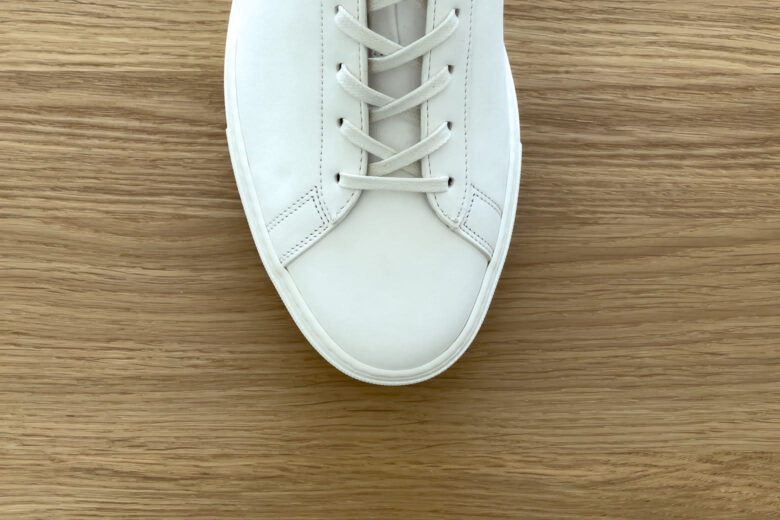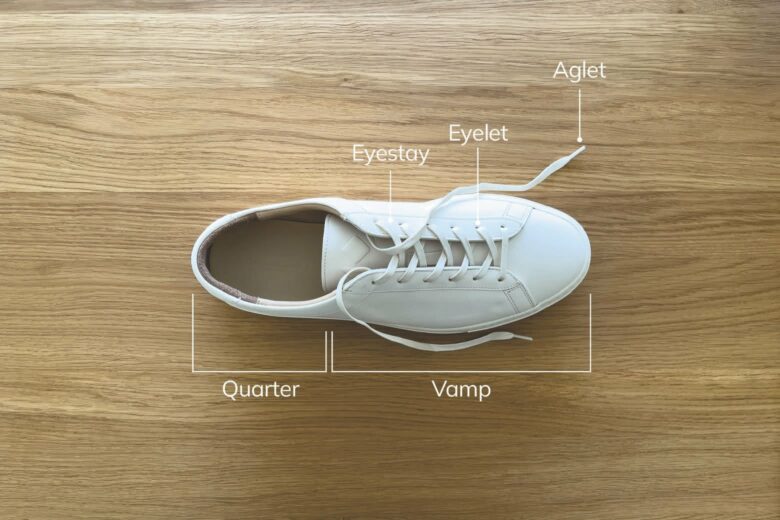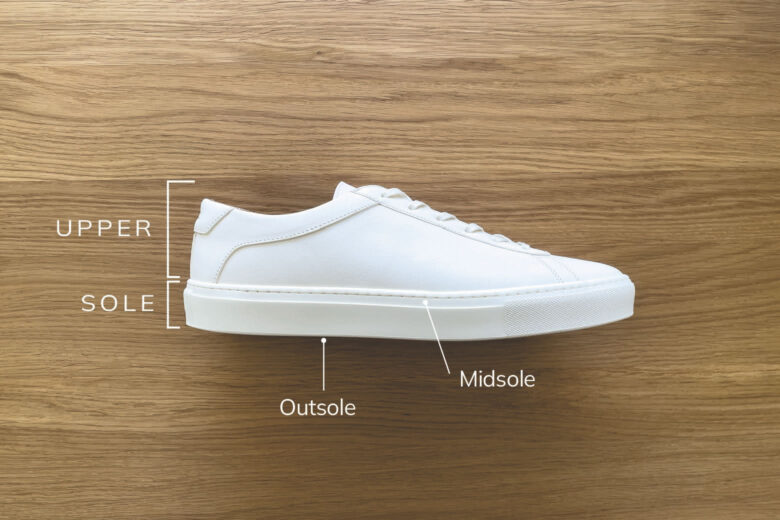Perhaps you’re a self-proclaimed sneakerhead. Perhaps you’re just dipping your toes (quite literally) into the industry jargon. Maybe you’re somewhere in between. Either way, knowing your sneaker anatomy has its perks when kicking back with the cool kids.
Starting with basics for beginnings—we’re talking uppers, vamps, and heel counters—and graduating with honors in sneaker tongues. We’re getting familiar with more advanced terms like foxing, quarter, and mustache.
We’re decoding the most ubiquitous shoe: the sneaker.
Worn by billions of people around the world, from track stars to streetstyle sartorialists, there are hundreds of sneaker designs to choose from. Which is why here at Luxe Digital we have spent years testing and scrutinizing the best luxury sneakers for men and for women in the market.
But before you get your hands on (or feet into) these cult favorites, we recommend a refresher course in the anatomy of a shoe. After all, how else do you know which soul (sole?) to invest in and which to kick to the curb (sorry we had to)?
Sneaker parts and their functions at a glance
| Category | Shoe part | Function |
| Upper | Toe box | Protects toes from impact |
| Upper | Heel counter | Secures and stabilizes the heel |
| Upper | Collar | Cushions the ankle and opening of the shoe |
| Upper | Tongue | Protects the top of the foot from lace pressure and evenly distributes tension |
| Upper | Vamp | Offers structural support, flexibility, and houses the fastening system |
| Upper | Quarter | Provides support and stability to the sides and back of the foot |
| Upper | Fastening system | Secures the shoe onto the foot, allowing for an adjustable fit |
| Sole | Insole | Offers comfort and support directly under the foot, can be removable for customization |
| Sole | Midsole | Provides cushioning and shock absorption |
| Sole | Outsole | Ensures traction and stability on various surfaces, as well as increased durability |
Upper
The upper of a sneaker is the part of the shoe that encases the foot. Crafted from materials ranging from traditional leather to innovative synthetics and textiles for breathability and durability, its primary role is to secure and protect the foot. However, the upper also serves a pivotal secondary function: it’s the sneaker’s sartorial hallmark, making every step a thoughtfully selected style statement.
Heel Counter
The heel counter is the stiff material hidden beneath the outer material at the back of the shoe. It’s designed to secure the heel in place, preventing excessive movement that could lead to discomfort or injury. Made from rigid materials like plastic or composite fibers, the heel counter aids in aligning the foot, enhancing the shoe’s overall support, maintaining its shape, and extending its lifespan.
Collar
The collar of a sneaker is the area that wraps around the ankle and the opening of the shoe. It’s pivotal for comfort and fit and usually features padding. This padding—referred to as collar foam—provides extra cushioning and support, reducing the risk of blisters and chafing, while improving the shoe’s overall stability.
Tongue
The tongue of a sneaker is a strip of material that sits beneath the laces, running along the top of the foot. Often misunderstood as the pesky piece that requires extra effort pulling up, Its importance cannot be overstated. The tongue cushions the foot against the pressure from the laces and distributes lace tension evenly to prevent discomfort, ensuring a snug fit. Commonly padded for extra comfort, it has become a point of innovation, trending towards the ankle-hugging “sneaker sock” technology inspired by high tops.
Toe Box
The toe box, an integral component of the upper, is the front section that covers and protects the toes. It varies in shape—from rounded or pointed to square—each influencing the shoe’s overall style and comfort. As one of the key parts of a shoe, fit is extremely important. The toe box should allow for some movement and prevent constriction while stabilizing and securing the foot. By reinforcing this area, the toe box also enhances the shoe’s durability, resisting wear from continuous toe flexion and impacts.

Quarter
The quarter is a key section of the upper, covering the sides and back of the foot, wrapping around the heel. It complements the vamp in fashion and function by providing additional structure and support. While it can be made from the same materials as the vamp, such as leather, mesh, or synthetic fabrics, variations exist for aesthetic or performance reasons. For example, a quarter overlay—often crafted in a different material to the quarter— is frequently used for extra durability, support, or as a design statement.
Vamp
The vamp is the part of the upper that covers the top of the foot, extending from the toe box to the quarter. It plays a crucial role in providing structural support and flexibility, ensuring the sneaker adapts to foot movements. Performance sneakers often feature breathable, lightweight materials like mesh for enhanced ventilation, while fashion sneakers might opt for leather, suede, or textiles for a stylish finish. Many vamps also have ventilation holes—often seen in high-performance designs—to improve airflow and comfort.

Fastening system
The fastening system of a sneaker is designed to secure the shoe on the foot, ensuring a snug and adjustable fit. The three main types of fasteners are laces, straps, and slip-ons, each catering to different preferences and needs. However, for this article, we’ll focus on the most common fastening system for sneakers: laces. Laces are versatile and customizable, both of which are crucial for optimal comfort and performance.
Eyelet
Eyelets are small holes located on the upper part of sneakers. They serve as guides for laces, ensuring smooth threading and effective fastening. This simple-yet-essential part of the sneaker anatomy is crucial for adjusting the fit to secure your foot.
Eyestay
Eyestays are the strips of material, often made from leather, fabric, or synthetic overlays, that reinforce the area around the eyelets on a sneaker. They provide added durability and support to the fastening system, ensuring that the eyelets remain in place and that the lacing system functions effectively.
Aglet
A small but significant component of the sneaker anatomy, an aglet is the plastic or metal sheath that wraps around the end of a shoelace. Its primary function is to prevent the lace from fraying, making it easier to thread through eyelets. This detail is particularly helpful when you need to re-lace your sneakers in a hurry.
Sole
The life and sole (sorry we had to) of any shoe, the sole is the foundation of the sneaker. It comprises three main layers: the insole, midsole, and outsole. And while its primary function is to provide cushioning, support, and protection to the foot, recently the sole has become somewhat of a style statement. From chunky lugs and layered platforms to smooth flats and high performance foam, your sneaker soles say a lot about you.

Outsole
The outsole is the bottom layer of the sole that makes direct contact with the ground. It’s crucial for durability and traction, ensuring the wearer’s stability and safety on various surfaces. Outsoles are typically made from rubber or synthetic materials, designed for resistance against wear and optimized grip. Some outsoles are one piece for uniform protection and performance, while others are split into two to enhance flexibility and adaptability, catering to specific movements and providing targeted support.
Midsole
Defined as the layer between the insole and outsole, the midsole is one of the most important (if not the most important) parts of a shoe. Crucial for cushioning and shock absorption, the midsole is usually made from foam materials, such as EVA (ethylene-vinyl acetate) or polyurethane, to balance softness with support.
Performance midsoles are engineered for specific activities—often targeting things like rebound ability and impact protection—whereas fashion midsoles usually prioritize design and general comfort over technical specifications.
Insole

The insole is the innermost layer of the sole, sitting directly beneath the foot. It plays a vital role in providing comfort and support, shaping the footbed to enhance the shoe’s overall fit and feel. Commonly crafted from foam, gel, or fabric, insoles can be tailored for specific needs, such as extra arch support or cushioning. They can either be drop-in (removable or replaceable) or attached (glued to the base).
Other useful terminology
So apparently, “foxing” isn’t just a term reserved for hunters, and a “quarter” isn’t always a coin worth 25 cents. In the sneaker industry, the terminology used can be just as intricate as the designs themselves, often perplexing the non-sneakerheads amongst us. In fact, even self-proclaimed sneaker nerds may encounter problems decoding the many parts of a sneaker.
Whichever you identify as, here’s all you need to know to start speaking sneaker.
Colorway
The colorway of a sneaker refers to the specific combination of colors applied to its design, encompassing everything from the upper to the sole. It’s a critical aspect of a sneaker’s identity, influencing its appeal and unique aesthetic. Colorways can range from monochromatic schemes to intricate blends, often distinguishing limited editions and special collaborations from capsule wardrobe classics.
Mustache
The “mustache” of a sneaker is a descriptive term that refers to the small piece of material located at the back of the shoe, near the heel. This element resembles a mustache in shape and is typically found where the upper meets the sole. Slightly puffed up by nature, the mustache adds structural support, as well as being a key design element in modern footwear.
Foxing
Foxing, in the context of sneaker terminology, is often misunderstood but specifically refers to the material located at the heel, covering the entire back of the shoe. This crucial detail is not just about aesthetics and style, it plays a significant role in the shoe’s longevity. If your sneakers don’t fit correctly, the foxing is what will start to wear away quickly, emphasizing the importance of a proper fit.
Lining
The lining of a sneaker is the material inside the shoe that comes into direct contact with the foot. It’s designed to provide comfort, enhance fit, and manage moisture, keeping the foot dry and comfortable throughout wear. Typically made from breathable fabrics such as mesh or synthetic textiles, the lining plays a pivotal role in the overall comfort and wearability of the sneaker. It also contributes to the shoe’s durability by protecting the interior from wear and tear.
Padding
The padding of a sneaker refers to the cushioning found throughout the shoe—including the collar, tongue, and around the ankle area—designed to enhance comfort and support. While related to the insole, which specifically lies under the foot, padding is more extensive, contributing to the overall fit and protection of the foot against pressure points. Both elements work together to ensure a comfortable, snug fit, but serve slightly different purposes within the shoe’s structure.